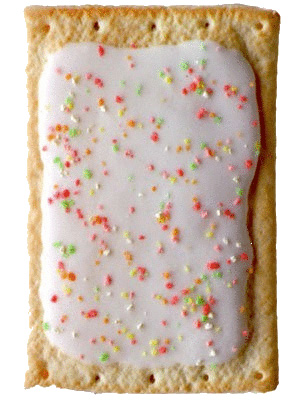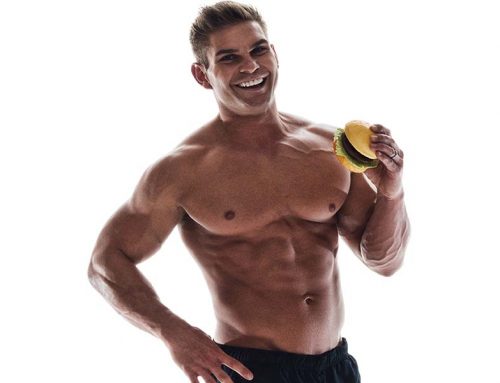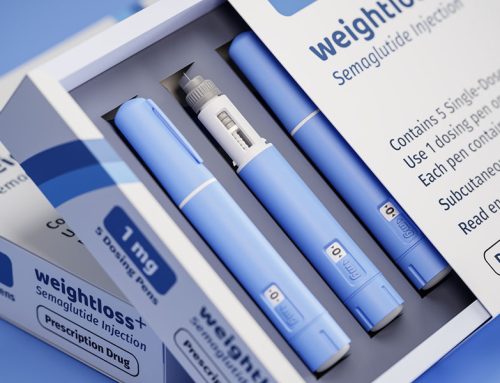IIFYM is an acronym for, “If it Fits Your Macros.” “Macros” of course, is shorthand for macronutrients – protein, carbohydrates and fats. What does this have to do with Pop Tarts? Keep reading and you’ll find out. The spread of IIFYM through the online diet world has led to some absolutely epic debates, controversies, and misunderstandings, depending on how different people explain or interpret IIFYM

IIFYM promotes flexible dieting, where you don’t have to be super strict with your food choices – you can allow a certain amount of your calories to come from any junk food you want, from Pop Tarts to Ice Cream as long as your track your numbers – protein, carbs, fats and calories – and get your numbers right.
I’m a supporter of flexible (and customized) meal planning, and always have been, but I have some mixed feelings about this IIFYM craze – and you’ll understand why by the end of this article. Some of my dislike has less to do with the premise, and more to do with the attitude of the practitioners.
Another problem is that IIFYM has no official definition, leaving it very open to misinterpretation. You could even argue that the name implies, “If you hit your macros, THEN anything goes – eat whatever junk food you want.” Without a deeper explanation, it sounds that way on the surface, doesn’t it? (which is why I don’t really care for the name, IIFYM).
So why don’t we start by defining IIFYM and trying to figure out, what was the original intention?
What is IIFYM and how did it get started?
First of all, some people call it the “IIFYM diet.” However, most people who support this approach say that IIFYM is not a diet or a specific nutrition protocol. IIFYM is simply an eating philosophy that recommends flexibility in food choices instead of rigid dieting, (which requires you to eat 100% “clean” or follow strict lists of specific foods).
Legend has it that IIFYM was not the brainchild of any particular diet guru, like most brand name diets. It started literally by accident in one of the popular online bodybuilding forums, where newbies were constantly asking the experienced members, “Can I eat this?” Is it okay to eat that? Will this food make me fat? Will that food make me fat?” and so on.
Anyone who is knowledgeable about nutrition knows that individual foods don’t make you fat per se, it’s an excess of calories makes you fat.
So finally, (after starting to get annoyed), one of the senior forum members said, “As long as it fits your macros and it fits into your calorie limit, THEN you can eat it and you’ll still lose weight.” A newbie repeated back, “If It Fits Your Macros, you can eat it???” And so a simple conversation in a forum gave a name to a new movement, which quickly attracted a loyal tribe of followers (which is not surprising, considering it gives you permission to eat more junk food).
Many dieters once believed, and many still believe, that if you eat “junk food” such as doughnuts or candy or potato chips or ice cream (or pop tarts), those foods automatically turn into fat, regardless of how many calories you consume (because they are “bad” foods or “fat storing” foods). That’s actually ridiculous when you think about the laws of thermodynamics.
It really is true: If you’re in a calorie deficit, you will lose weight even if some of the calories come from junk. Calorie deficit = weight loss. (However, habitually eating a lot of junk food can be harmful to your health, and we’ll come back to that shortly).
Almost everyone agrees that IIFYM was never intended to mean eating nothing but junk food. IIFYM practitioners are simply saying that it’s not necessary to eat 100% “clean” and in fact, that it’s better for your long-term success and mental well-being to be more flexible.
It logically follows then, that if all it takes to lose weight is a calorie deficit, then why restrict yourself exclusively to traditional (boring) diet foods like egg whites, chicken breast, fish, salad, broccoli and so on?
Why not enjoy yourself a little and create your meal plans based on personal preference? Why not allow some room in your calorie budget to include your favorite foods? Won’t you enjoy your meal plan more that way? Won’t you be more likely to stick to your plan? These are good questions.
In IIFYM, you create meal plans or track food intake by the numbers: calories, protein, carbs and fat. Mobile apps are an IIFYMers best friend. The food selection remains flexible, based on healthy foods you enjoy (which is why this approach is also known as “Flexible dieting”), and you also allow yourself a certain amount of calories from any junk food indulgence you want.
IIFYM: New name, but NOT a new concept
Although IIFYM hit the scene fairly recently (and is widely embraced by the younger generation), this is not a new concept. For years, many popular fat loss programs have recommended including occasional cheat meals or free days. In Burn the Fat, Feed the Muscle (BFFM), we have always built meal plans by the numbers (calories and macros) and we have always allowed for some flexibility on food choices.
Some people have even gone as far as saying that “BFFM follows an IIFYM approach,” but I would object to that because, one, BFFM was here long before IIFYM, so if anything, IIFYM followed BFFM. And two, I would prefer Burn the Fat, Feed the Muscle be classified as a flexible bodybuilding-style eating plan, not as “IIFYM”).
The difference is, many practitioners of IIFYM point out that you can (or insist that you should) have a small amount of junk food every day (rather than just an occasional cheat meal or free day). You could do that and still lose weight, but I don’t think that’s a good idea for everyone.
In IIFYM we also don’t know what percentage of our calories should be “clean” (unprocessed, micronutrient-dense food) in order to reach our body composition goals while also staying healthy. Or, approaching it from the opposite angle, what percentage of your calories should be allowed as junk food?
The problem is, there’s no “official guide” to IIFYM that specifies a number. Every IIFYM practitioner has their own rules. Some IIFYMers simply say hit your macros, hit your calories and “hit your micros” (ie micronutrients and fiber) and after that, fill in the rest with all the junk you want. Many don’t give a number at all, and when they do, opinions differ from one practitioner to the next.
One prominent you tuber says the number should fall between 60% to 90% nutritious food and the rest you can fill in with pop tarts and ice cream, if that makes you happy. That’s a pretty big range, isn’t it? You can lose weight on a low calorie junk food diet, but if you eat almost half of your calories from crap, can you really say that is healthy?
Very few IIFYMers discuss in detail the health impact of the diet – their support for this approach tends to revolve the fact that they can eat junk and still get lean. My approach focuses on getting leaner and healthier.
The advantage of flexible dieting over rigid dieting
What do I think about IIFYM? Well, as I mentioned before, I’m very much in favor of flexible dieting over super strict dieting. Research supports the idea as well. Studies have shown that diet programs which are too rigid are harder to follow and have a higher dropout and relapse rate. Eating plans that allow for personal preferences and allow favorite foods have a much higher success rate.
I also believe that tracking calories is the ideal approach. It’s certainly possible to be successful without calorie counting, especially after you’ve done some food journaling for a while, but people who track calories are almost always more successful. Calories matter. A calorie deficit is a required condition for weight loss.
Macronutrients matter too. There’s no perfect macronutrient ratio that’s ideal for every goal and every person, and micromanaging your macronutrients is not necessary, but getting the right amount of protein, carbs and fat for your goals is important (it’s especially important to hit your protein goal every day).
It’s important to take your personal preferences into account when creating your own meal plan rather than letting a rigid diet program completely dictate what’s allowed and what’s forbidden. IIFYM advocates believe, and I agree, that it’s counterproductive to have forbidden food lists at all.
Despite this, the entire mainstream diet industry is based on the premise that certain foods are bad and certain foods are good; some foods are fat-storing and some foods are fat-burning. Outside of the fact that some foods are very calorie dense, and very palatable (making them very easy to overeat – and some people would argue, addictive), this is not true.
With the exception of food allergy or intolerance, you can eat any foods you want with no ill effects on your health or body composition, if you consume them in reasonably small amounts.
I’ve seen people eat a diet that consists primarily of traditional bodybuilding foods (about 80-90% of the calories), but they allow the remaining 10% to 20% of their calories to come from junk food – a piece of chocolate, a pop tart, a bowl of sugary cereal, a sandwich made with white bread, or whatever they want. They were tracking their calories and macros carefully, and there was absolutely no difference in their body composition results compared to before, when their foods were 100% “clean.”
It’s hard for some “health foodies” to accept, but this kind of approach to flexible dieting is reasonable, rational, realistic and it does work.
The danger of taking flexible dieting too far
As you can see, in many ways, I agree with the IIFYM approach, although I prefer the term flexible dieting. However, it’s very possible to get too flexible.
I believe we could avoid this problem simply by setting some boundaries with a number. After all, if the spirit of IIFYM is about doing nutrition by the numbers (calories, protein, carbs and fat), then why not define a specific number for how much flexibility is allowed.
My feeling is that the majority of your calories should come from nutrient-dense, mostly unprocessed food for one big reason: Health. If you’re too focused on macros and food quantity alone and you don’t pay enough attention to food quality and nutritional value as well, then at some point, your health will begin to suffer.
I think some IIFYM advocates take it too far. They want to see how much junk food they can get away with eating before they see any negative effects. The younger guys – the teenagers and 20-somethings – are especially known for this, but I’d like to know how many of our 40-60 year old readers think they can eat like they did at 21 and still get the same results in body composition, performance and health?
No matter what your age, I believe it’s smarter to approach it from the opposite angle: I think you should eat as much nutrient-dense and natural (aka “clean”) food as possible and put a number on your target. Not an absolute number for everyone, but a number of your own choosing, for the sake of planning and accountability.
I call this a compliance rule for food quality.
What is a reasonable compliance rate for food quality that will support good health, top performance and optimal body composition, as well as make it a lifestyle that you can easily follow long term?
For many years, I have recommend 90% compliance to the “clean” foods list. Too strict for you? No worries, relax a bit more (make it a bit more “flexible”) and have a compliance rate of 80-85% or whatever. Just aim for getting the majority of your calories from natural, unprocessed, nutrient-dense foods, leave a little room for discretionary calories, and track your numbers.
Warning: rant ahead…
Bodybuilders and fitness enthusiasts are often very passionate about nutrition and health food, and eating clean 90 or 95% of the time is their preference. Eating unprocessed whole food becomes a habit, not a hardship. In fact, they enjoy eating the most nutritious foods possible, as often as possible, because of the way it makes them feel. They feel lousy both physically and mentally when they eat a lot of junk food.
One of the reasons for all the controversy over this subject is that IIFYM advocates often start arguments that people who eat “too clean” are uninformed, obsessive-compulsive or “orthorexic.” (orthorexia is the name for a non-clinical eating disorder characterized by obsession with eating only health food or natural foods).
What’s more, many followers of IIFYM have some kind of vendetta against the phrase “clean eating.” It’s not uncommon to see hyperbolic blog posts titles like “clean eating is a big fat lie!” Yeah, we get it. We understand what flexible dieting is. We know you don’t have to eat 100% clean to be healthy and lean. That doesn’t mean it’s helpful to anyone to swing the pendulum to the other side and attack clean eating! Frankly, I think its just nit-picking over semantics anyway (call it quality eating if it makes you feel better).
I never thought I’d live to see the day, but I have actually witnessed some of the most popular fitness personalities today making fun of (“trolling”) or even attacking people for eating “too clean” or simply for following a traditional bodybuilding diet. If you mention you eat chicken breast, egg whites and Tilapia (and god forbid, 5 or 6 meals a day), they call you (in today’s internet bodybuilding vernacular) a “bro.” Then they tell you to “lighten up”… and eat some pop tarts.
I shake my head and roll my eyes in disbelief every time I see it. I think this behavior is unprofessional, disrespectful and immature. That’s why I’ll conclude by saying that flexible dieting, done right, really is the wave of the future (and is a broad concept you can apply to any nutrition program). But on the other hand, the only thing dumber than the IIFYM acronym is the online behavior of it’s most outspoken proponents.
Train hard and expect success,
Tom Venuto,
Founder, Burn the Fat Inner Circle
Author, Burn the Fat, Feed the Muscle (BFFM)
Author, The BFFM Guide To Flexible Meal Planning
PS. By the way, I still have no idea why IIFYMers like Pop Tarts so much and why they show up on their meal plans so often as a favorite indulgence. If I’ve got some discretionary calories to spend, I can think of a lot better ways to spend them, can’t you? Well … to each his own… Then again, I did eat a few on my thru-hikes
PPS. For more information about Burn the Fat, Feed the Muscle (BFFM) – a flexible bodybuilding-style nutrition program visit: http://amzn.to/2yLj9yt
NEW! TNB TURBO Training System: Ultra-time efficient “superset” training proven by science to build muscle in 50% of the time. To learn more CLICK HERE






I agree with you Tom 100%.This iifym sounds to me like an “easy way out” of doing things properly,
I think a lot of this “anti-bro” backlash comes from the fact that eating clean is harder to do for a lot of people while on a iifym diet. At least that’s how I feel. I think some feel they need to bash the “orthorexics” to avoid acknowledging their own challenge of making a diet at least mostly clean and healthy while still fitting macros. It’s hard to do!
Counting calories is somewhat of a pain, no matter what. Even when your system and routine is totally dialed in, it’s another variable that needs attention and willpower. And, if you need more willpower dedicated to one variable to make everything work, then as time goes by other variables will eventually have to give, like making healthy food choices.
The temptation to eat more and more junk becomes that much easier to give into as long as the cut is still working. Whereas the consequenses of such are much less apparent and hard to gague: overall health, wellbeing, energy, ect.
As my most recent iifym cut went on, I definitely noticed that I got lazier and ate more junk. Sometimes it’s just straight up easier to eat a pint of frozen yogurt to carb up after a workout and say “whatever fits my macros” then to bake organic potatoes and whip out the food scale.
I’m not at all in denial that calories are ultimately the king when it comes to body composition, but still my ideal end goal is to be able to maintain my desired leanness and not have to count calories. I’d be thrilled if I could figure out how to effectively cut without counting, but I suppose that just takes practice and experience.
Great article! especially agree with your opinions of pop tarts … I’ll take a nice strong hoppy craft beer for my cheats :)
Another great article Tom.
I think there’s a danger that as soon as you start saying it’s OK to each junk in your diet then you start looking for how much you can cram in; making it all too easy to spill over and miss your targets. In other words, you’re not leaving yourself any room for accidents, slip-ups or moments of weakness. We’re all human after all.
Personally I try to stick to clean eating as much as possible because I know that at some stage someone is going to stick something I haven’t planned for under my nose and the situation or occasion is going to make it difficult to say no. If I’ve already had my junk for the day when this happens then I’m just going to blow my goals.
Besides, as you said on The Body Fat Solution, what really matters, and what really makes you a strong person is not the end product, but the road you had to take in order to get there. In other words, what really matters about fighting for a good physique, is not the great body you get (that is just a by-product); it is the discipline, determination and hard work what really makes you stronger. And sticking to a IIFYM approach is not even close to the experience of the discipline and hard work of bodybuilding.
Besides, I am sure that those who follow the IIFYM approach are very far from achieving the full potential of their bodies. It’s a mediocre approach.
Always a pleasure to read. Keep up the good fight!
I know that when I eat 90-95% clean, I don’t feel good. I may be losing fat, but I feel like I have the flu the entire time. The cure for me is pasta. Alfredo. When I find that I jut don’t have any energy, and I am unable to concentrate on anything, that is the one thing that gets me back in track. It’s my pop tart.
But I make my own pasta. And some days I will make it with a combination of whole wheel flour, oat flour and/or rice flour. And eggs. Always eggs. No processed and packaged pasta.
And the sauce is heavy cream, butter, and fresh Parmesan.
And together it’s like crack as far as brain food. I am able to think straight again. And I have energy again. All the aces and pains go away and I can get back on track with my workouts.
And I don’t even care if it fits my macros that moment.
The important thing is how I feel. If I feel like crap (and I do feel awful when I limit carbs and fat in favor of protein calories) then I start to miss workouts because I just don’t have the energy. Or I do the workout first and then I am useless the rest of the day.
I consider pop tarts to be similar to a candy bar with the sugar content. Just sugar isn’t what works for me. But if it does work for someone else, then good for them. Maybe it’s psychological. Maybe they love pop tarts and eating them just makes them happy. And when they are happy they are more motivated to do their workouts and do everything they need to do to stay on track so the pop tarts don’t affect their progress negatively.
For me, I wouldn’t eat them just because they are processed. All the chemicals and preservatives affect me. That why I make my own pasta and sauce from scratch. If I opened a jar and boiled a package of noodles I would still feel like crap. But my own pasta or bread plus egg protein and dairy based fat? Oh yeah. That’s brain food. I can function much better if that is my periodic cheat.
I think the IIFYM idea can work as long as people are paying attention to their own goal and their own progress. And don’t assume that what does or does not work for one person will or will not work for another.
Love this comment !
This is exactly how I feel, especially when I’m about to write a good part of my thesis.
I just sit down and have my craving because I am able to concentrate and be more productive afterwards, than be obsessed with the food I can’t have.
IIFYM tracks fiber intake. This is because of thermodynamics. You can’t hit your fiber number if you just sit and eat pop tarts. Basically anyone cutting is trying to hit their fiber number which is roughly 1/8 of the carb intake. You can’t sit and eat pop tarts and all processed food to hit your fiber on a cut. You’re getting trolled or watching someone incorrectly use IIFYM if they are just eating junk food all the time. It’s the most superior way to cut weight long term because it avoids a rebound from the torture of chicken and rice constantly.
I don’t get why people like to rail on each other for choosing iifym or clean eating, like they’re mutually exclusive. I like iifym but it doesn’t mean I don’t enjoy real food like chicken breast, brown rice and eggs. Since I usually don’t have a big appetite or want to spend most of my day eating, sometimes I just have to drink shakes or carbonated drinks to reach my macros, or even a few slices of pizza if I hardly ate that day